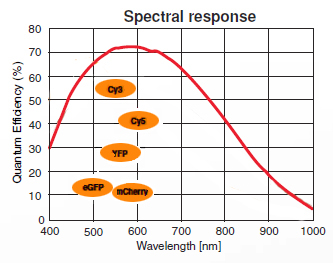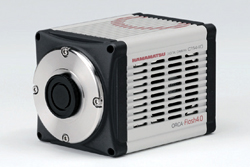World’s first Gen. II sCMOS camera: Hamamatsu presents ORCA-Flash4.0
High sensitivity and high-speed scientific imaging CMOS Camera
Hamamatsu’s brilliantly designed ORCA-Flash4.0 is truly a game changer in the world of scientific imaging. Built on a revolutionary new Gen II sCMOS detector, the ORCA-Flash4.0 is the first sCMOS camera that challenges the performance of all CCD, EM-CCD, and Gen I sCMOS cameras. With its combination of low noise and high quantum efficiency, the ORCA-Flash4.0 delivers unprecedented sensitivity as well as high dynamic range, blazing fast speeds, large field of view, and excellent resolution—all at once.
Scientists have used EM-CCDs for very low-light, often high-speed imaging such as TIRF or spinning disk confocal, while they have relied on cooled CCDs for other fluorescence applications such as GFP or multichannel imaging. But the ORCA-Flash4.0 is changing all of that. Now one camera covers a wide range of imaging needs—including localization microscopy, TIRF microscopy, live cell GFP, high-speed calcium ion imaging, FRET, real-time confocal microscopy, and many more.
ORCA-Flash4.0 features:
- Exceptional sensitivity: over 70% quantum efficiency at 600 nm
- Low noise: 1.3 electrons at 100 frames per second
- High speed: 100 frames per second at full resolution
- High resolution: 4.0 megapixels with 6.5 x 6.5 µm pixel size
The main features and benefits of the ORCA-Flash4.0 camera are summarized below.
For more info visit our website.
Image A (left): HeLa cells labeled with d2EosFP. Left: reconstructed PALM image. Right: single TIRF imagefrom data used for reconstruction.
(Images courtesy of Prof. Zhen-li Huang, Britton Chance Center for Biomedical Photonics, Wuhan National Laboratory for Optoelectronics, Huazhong University of Science and Technology.)
Image B (middle): Ins-1 cell MARCS-DsRed
(Image courtesy of Dr. Hideo Mogami, Hamamatsu University.)
Image C (right): HEK293 cells stained with Fluo8-AM, Yokogawa CSU Spinning Disk Confocal
Special features sCMOS camera ORCA-Flash4.0
 High QE + Low Noise = High Sensitivity
High QE + Low Noise = High Sensitivity
The ORCA-Flash4.0’s high sensitivity results from its high quantum efficiency (QE) and low noise. The camera’s Gen II sCMOS sensor provides high QE across the range of wavelengths most commonly used in fluorescence microscopy, with QE values over 70% at 600 nm and 50% at 750 nm. Add the low read noise of 1.3 electrons at 100 fps without EM-CCD multiplicative noise, and you have an extremely sensitive and versatile camera. You can detect signal at low light levels, compare small changes in intensity, and discriminate small signals amid large backgrounds—with ease.
High speed
The sCMOS camera ORCA-Flash4.0 features 100 frames per second imaging at full resolution. For those experiments that need even more temporal resolution, the ORCA-Flash4.0 delivers even higher speeds with a smaller region of interest.

Photo by Hamamatsu Corporation
Full Resolution:
2048 x 2048 @100 frames/s
Sub-array readout (Typical examples):
2048 x 1024 @200 frames/s
2048 x 512 @400 frames/s
2048 x 256 @800 frames/s
2048 x 64 @3200 frames/s
2048 x 8 @25,600 frames/s
Wide field of view and high resolution
With 4.0 megapixels at 6.5 x 6.5 µm each, the ORCA-Flash4.0 offers a field of view 2.5 times larger than a standard EM-CCD. In addition, this camera’s smaller pixels can resolve much finer details than the larger pixels on an EM-CCD camera.
Comparison of field of view
Field of view is 2.5 times larger than that of a standard EM-CCD camera.
Comparison of resolution
The 6.5 μm × 6.5 μm pixels of the ORCA-Flash4.0 enable much finer detail to be resolved when compared to the 16 μm × 16 μm pixels of an EM-CCD camera.

Photo by Hamamatsu Corporation
Other features
The ORCA-Flash4.0 is a solid piece of camera engineering. It has optimized cooling and outstanding image uniformity across the entire sensor compared to cameras based on Gen I sCMOS technology. Other features include 16-bit A/D converter and multiple external trigger and timing output functions.
Applications
- Localization microscopy
- TIRF microscopy
- Live cell GFP
- Time lapse fluorescence
- Ratio imaging
- FRET
- High-speed calcium ion imaging
- Real-time confocal microscopy
- Light sheet microscopy
- Morphology
- Fluorescence in situ hybridization (FISH)
News Categories
- » NEWS HOME
- » Automation & Robotics
- » Industry 4.0
- » Material Handling
- » Sensors
- » Quality & Testing
- » Machine Vision
- » Laser & Optics
- » Metalworking
- » Motion Control & Drives
- » Hydraulics & Pneumatics
- » Process Industry
- » Renewable Energy
- » Agriculture
- » Home & Office Furniture
- » Environmental Tech



